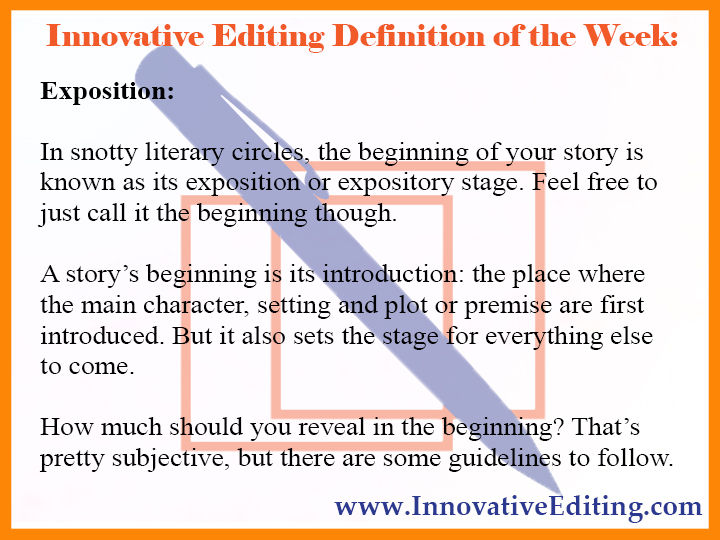How to Begin a Story: Story-Building Step No. 1
- Jeannette DiLouie
- Jun 6, 2017
- 4 min read

Today’s writing Definition of the Week, as posted on Innovative Editing’s Facebook page, is for “exposition.”
In snotty literary circles – which, rather like the scientific community, loves to come up with intellectual-sounding jargon for really simple ideas – the beginning of a story is known as its exposition or expository stage.
Feel free to just call it the beginning though. Or first chapter. Or starting point. Whichever works best for you.
Regardless, a story’s beginning – its exposition – is its introduction: the place where the main character, setting, and plot or premise are first introduced. This is where readers get to learn who and what the protagonist is and what kind of situation they’re either in already or about to get into.
If that sounds simple enough, it both is and isn’t. Because while it simply says, “Hi reader, this is your main character,” it has to do that in a way that sets the stage for everything else your story will cover.
So how much should you reveal in the beginning, and how much should you establish? That’s pretty subjective, but there are some good guidelines to follow. For starters, try these on for size:
Make your protagonist stand out. Your whole manuscript is going to follow a main character or main characters. After all, stories are about individuals or personalities going on journeys. And nobody wants to go on a journey with a boring or lackluster or incomplete companion. Therefore, let your protagonist shine in the opening chapter, making sure he, she or it comes across as real, as likable and as interesting as possible.
Tell your readers their travel companion’s name, age, and personality quirks. Is she a college student named Sophie with an A-type personality? Is he Trent, a 40-year-old engineer who hates his life but doesn’t know how to change it? Or perhaps it’s a horse named Lucky who can’t seem to win a race.
Whatever main character or characters you’re writing about, make them tangible and understandable right there in those first pages.
Establish the setting. In order to understand where they’re going, readers have to get a good, fast grasp of where they’re starting out. While the front cover of your finished, published novel is probably going to offer a hint or two about this, it’s your written-out beginning that really needs to set the scene. If your characters are operating on some non-human world, whether fantasy or sci-fi, that needs to be established in the first few paragraphs. In fact, even if it’s anywhere U.S.A. in the 21st century, you need to make that known as quickly as possible. Let’s say you’re working on a Western, filled with cowboys and outlaws. In that case, you could have your main character strolling through the dusty streets in his cowboy hat, wondering if Ms. June in the saloon over there will spare him a bowl of stew. If it’s more of a modern story, Priyanka and her best friend Trish can be sitting at lunch in the high-school cafeteria, talking about how utterly boring math class was last period. Or Lee can be looking at her narrow, orange prescription bottle, wondering how she got to where she is. You never have to flat-out say, “It was the year 2525, and the Mordceats were on their intergalactic war path again.” But maybe have main character Rigel outside on the spacewalk when his earpiece buzzes with the news that he needs to return to the spacecraft right away. Just like that, readers will have an instant idea of what picture they’re looking at.
Give readers some reason to want to know more. So you’ve got yourself an awesome, established main character, and a really sweet setting. But now you need to at least hint at what’s to come.In other words, start some drama. Actually, that Rigel example in the last bullet point works really well here too. Rigel can race to the briefing room, only to find the general, first officer and five other high-ranking scientists all sitting around the conference table. They already have their simulations running, which show a horde of fighter ships streaking toward their much larger but less-armored spacecraft. Oh no! What ever’s going to happen next? Readers will just have to keep flipping those pages to find out. That’s a fairly intense beginning, admittedly. You can take it a lot more slowly than that by giving your main character an ordinary life with some aspect he wants to change. Maybe Jon is sitting on his bed, missing his ex-girlfriend, who left him one whole year ago. That then begs the question of whether he’ll be able to get over her. And how? Or will she come waltzing back into his life wanting to try again? Or Billy could be working hard at her archeological dig when she discovers something odd in the trench she’s been sifting through. It doesn’t explode or tingle with power or even look all that ominous. Yet something about it makes her shiver with some mixture of excitement and dread. Why? Again, there’s no way to know if readers don’t move on past the beginning.
There are so many other guidelines to give when it comes to what makes a good story beginning. But those three above are the biggies.
Besides, if you’re working on your first draft, then you don’t want to stress out too much about your beginning right now anyway.
You’ll just have to tune in to Thursday’s Writing Challenge to find out why.




